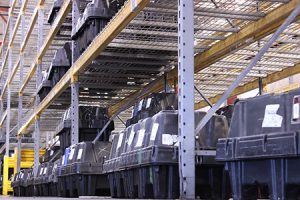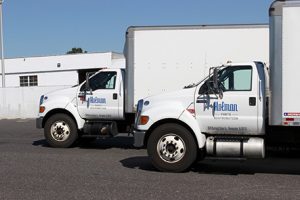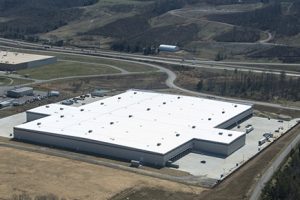Aftersales service is critical to a car buyer’s satisfaction and brand perception. We find out how OEMs are dealing with the growing pressures on North American parts distribution networks
 Identifying efficiencies in service parts distribution is a key issue for OEMs – servicing retail outlets is the primary goal of any parts distribution network, after all – but moving parts through the automotive supply chain in a way that meets the service expectations of the dealer network and its customers is very complex. In large geographical markets like North America, it requires an adaptive network of distribution centres (DCs), dedicated fleet management resources and a host of third party providers.
Identifying efficiencies in service parts distribution is a key issue for OEMs – servicing retail outlets is the primary goal of any parts distribution network, after all – but moving parts through the automotive supply chain in a way that meets the service expectations of the dealer network and its customers is very complex. In large geographical markets like North America, it requires an adaptive network of distribution centres (DCs), dedicated fleet management resources and a host of third party providers.
In this story...
The days of three-to-four days to get stock orders to dealers are now in the (recent) past. Recognition has grown that faster, more timely deliveries result in more satisfied customers, who are, in turn, more likely to buy the same brand from the same dealer again.
“Prior to 2013, two- to four-day stock order service was our standard. Today, over 97% of our dealers receive their stock order on a next-day delivery basis – 94% of them before 8am,” confirms Anu Goel, who in mid-October will be promoted to be Volkswagen Group of America’s executive vice-president of aftermarket and services, after leading its logistics until now. “If the dealer does not have the required spare parts on their shelf for the repair when a customer comes in, our network is designed to pick and ship the parts from a DC to arrive at the dealer’s repair facility the next day, before the service department opens, so the dealer can complete the repair as early as possible the very next day.”
This requirement is not unique to Volkswagen. “Dealerships and their customers will no longer wait for the OEM to fill a full trailer-load, just to accommodate the shipper,” says Fred Kimball, principal at Distribution Design, a consultancy.

The next-day schedule and the growing number of SKUs have also had an effect on just where to put the DCs in a parts supply network and how many are needed, points out Adam Mullen, director of supply chain services at commercial real estate giant, CBRE. Service levels to dealers and the OEM’s retail base will determine a DC’s location and size as well as the transport options, he suggests.
Working out the right ratio of DCs to dealerships is another issue. For example, Porsche operates with only three DCs in its North American network, servicing up to 80 dealerships apiece with a two-day delivery goal.
“Our ratio of distribution centres to dealers depends on geography and the volume of dealerships in a particular region,” comments Porsche’s Bob Semsch, manager of logistics and process improvements at Porsche Cars North America, which manages its domestic spare parts distribution mostly separately from Volkswagen in the US. “We have more dealerships on the west coast, so our Ontario, California DC handles more dealer volume than our other two DCs,” he adds.
[sta_anchor id="1"]Putting a contract outOutsourcing has gained significant momentum in automotive logistics over the last two decades, with 3PLs now touching every part of the supply chain. When it comes to parts transport, logistics providers are undoubtedly preferred to own-account fleets (although some OEMs, like Toyota in the US, do use their own trucks for some lanes), but for other areas of spare parts distribution, at least, the reviews are mixed. When it comes to warehousing, inventory management and IT functions, many OEMs still prefer to do things in-house.
Porsche is among those who have tried contracting out the wider logistics function but Semsch says the OEM elected to bring it back in-house 14 years ago, terminating a long-term relationship with a 3PL. “Porsche Logistics Services (PLS) is a wholly owned subsidiary of Porsche Cars, so we operate as our own profit centre. Taking the logistics functions under PLS’s control helped us improve several of our KPIs by 25%,” he explains.
“It all comes down to control,” comments Mullen of CBRE. “When a parts distributor reaches a certain scale and a solid operating foundation, handling the inventory management piece of the equation is often better done in-house.”
 "Our ratio of distribution centres to dealers depends on geography and the volume of dealerships in a particular region. We have more dealerships on the west coast, so our Ontario, California DC handles more dealer volume than our other two DCs." - Bob Semsch, Porsche Cars North America
"Our ratio of distribution centres to dealers depends on geography and the volume of dealerships in a particular region. We have more dealerships on the west coast, so our Ontario, California DC handles more dealer volume than our other two DCs." - Bob Semsch, Porsche Cars North America
Scale certainly is an issue, alongside customer commitment, when it comes to outsourcing decisions, agrees Volkswagen’s Goel. “When a company is smallish and just getting started in the distribution business, the use of 3PLs allows them to utilise existing networks and economies of scale, but once a distributor gets to a critical mass – and an increasing focus on customer expectations and lower costs – then it may make sense to internalise operations,” he states.
In terms of transport, however, there is widespread consensus that it’s a job best left to others. With most transport outsourced, a number of third party carriers have emerged as majors in the automotive sector.
Global 3PL Kuehne + Nagel (K+N), for example, has a dedicated automotive team that focuses strictly on parts distribution and automotive logistics, with dedicated warehousing services for OEMs that include Lexus and shared-user DCs for value-added services such as logistics engineering, technology applications and site selection. “We even offer our own production system, known as KNPS,” says Stephen Sargunaraj, director of contract logistics for automotive at the company. He adds that K+N also has its own software solutions for spare parts distribution, although he admits most OEM customers prefer to work with their own providers, including companies like SAP, Manhattan, Infor and Red Prairie.
[sta_anchor id="2"]Fast and flexibleOnce an OEM’s distribution network is established and its logistics partners are in place, much of any subsequent focus tends to fall on optimising warehouse throughputs via automation and innovation.
“The same fundamentals apply across all industry verticals when it comes to operating an efficient distribution centre,” says CBRE’s Adam Mullen. “Operationally, automotive DCs function in similar mode to other DCs in terms of service, transportation stem times and inside the four walls of the facility.”
Despite the fact that the automotive industry is known as one of the world’s most automated manufacturing sectors, spare parts warehouses are not generally highly automated, particularly compared to today’s e-commerce facilities.
“Our order picking is still done with carts,” admits Porsche’s Bob Semsch. “We have sophisticated retrieval software for order management, but we are not highly automated when it comes to actually picking the order.”
“When investing inside the box, the key is to balance the proper amount of space, labour and equipment,” says Mullen. “On the equipment side, throughput is enhanced by automated storage and retrieval systems (ASRS) and a host of other software and hardware solutions.
“Speed in operations is paramount in today’s distribution environment,” he continues. “We focus on cycle times – how quickly a part moves from its warehouse rack position to an outbound truck at the dock.”
[sta_anchor id="3"]Distributor growth and a ‘hybrid’ modelThe global parts distribution system is not just about OEMs shipping their parts from DCs to dealers; a number of original equipment and aftermarket parts suppliers also provide OEMs with warehousing and transport solutions, or sell and deliver parts independently. Unsurprisingly, perhaps, some OEMs prefer to partner with parts distributors as they obviously know the aftermarket parts business well, providing reliability and delivery expertise.
One example is Ford-authorised distributor Holman Parts, a New Jersey-based conglomerate of six privately held automotive-related entities that began its foray into the automotive industry as an operator of car dealerships.
“We touch all facets of the automotive industry,” comments Holman Parts’ logistics manager, John Conte. “For over 50 years, we’ve been a one-stop shop for automotive.”
 Ford-authorised distributor Holman Parts has a 'hybrid' distribution model, operating its own distribution centres in some areas and partnering with 3PL Ceva Logistics in others
Ford-authorised distributor Holman Parts has a 'hybrid' distribution model, operating its own distribution centres in some areas and partnering with 3PL Ceva Logistics in othersWhen it comes to warehousing and distribution, Holman has embraced a hybrid outsourcing solution across the 11 markets it services in the US; for seven of those markets it operates its own DC in each with in-house staff and delivery vehicles, while partnering with Ceva Logistics to operate the other four with a DC each in Atlanta, Kansas City, Dallas and Sacramento.
“Based on Holman Parts’ interest in expanding our coverage outside our core markets in the north-east, we partnered with Ceva,” confirms Conte. “The Holman Parts name was so well-known in our core markets for years that crossing from dealership sales into parts distribution was not difficult. However, in other US markets, we were not as well established, so partnering with Ceva was a solid decision for our business plan.
“We wanted a single-source provider who knew our business, was a leader in implementing our IT systems, and had a global presence for port access,” Conte adds. “We value the Holman Parts brand in our third party markets, so we hold our logistics partners to a high standard of performance metrics and KPIs. We see our transportation and warehouse suppliers as an extension of our supply chain.”
[sta_anchor id="4"]Thinking inside the boxLike other industries in the warehousing and distribution business, automation, optimisation and lean management have all taken centre stage in the automotive parts sector to improve efficiency and speed of delivery to customers. Ultimately, the operational efficiency of the distribution network is what drives the auto parts supply chain. “Finding the right balance is the key,” says CBRE’s Mullen.
Fred Kimball of Distribution Design agrees. “Balancing inventory-carrying cost, staffing, network optimisation, facility cost, automation and software provides solutions for a responsive parts distribution operation,” he says.
Some 3PLs aspire to a very holistic approach to improving an OEM’s logistics platform. “At K+N, we have a production system that operates like the Toyota model, promoting Japanese concepts like ‘lean’ and ‘continuous improvement’ to provide OEMs with efficiency in parts distribution,” says Sargunaraj.
Others concentrate more on on the simple space inside a facility’s four walls. “Our consulting focus starts from the dock doors, looking inside the warehouse,” states Kimball. “We leave the network design to others and provide optimisation on throughput via automation, rack system layout, conveyors and software solutions.”
[sta_anchor id="5"]From tactical to strategicImproving spare parts order-to-delivery times in an OEM’s retail network to achieve the service level expectations of today’s consumers often takes a strategic approach and a consortium of in-house strategists and third party consultants, while expanding an OEM’s operating platform requires substantial investment in time and capital.
 Volkswagen Group opened a new warehouse near Sacramento, California (pictured) that freed up space at another site in southern California where it began sharing space with Porsche
Volkswagen Group opened a new warehouse near Sacramento, California (pictured) that freed up space at another site in southern California where it began sharing space with Porsche“We are currently in the midst of a greenfield study to evaluate the need for a fourth distribution centre,” says Porsche’s Bob Semsch. “Most of our dealers receive inventory in two days, which we’ve found is satisfactory in most cases.”
“We use a ten-year plan for our distribution model,” adds Semsch. “However, we commission a study every six years to validate where we are. It’s not uncommon for us to make adjustments to our ten-year plan. In our six-year assessments, we evaluate the distribution network, our dealer delivery satisfaction, transportation modes and each service provider.
“Freight savings are often the main driver in where to locate a DC,” he adds. “The cost of a DC can pay for itself in one year with the right location that provides a substantial reduction in transportation costs.”
New strategies in distribution network design include breaking down the network by SKU, not just by dealer locations. “Product categories may one day be the main factor in warehouse network design, particularly when assessing SKU velocity, age of the car and efficiency,” says Adam Mullen.
Anu Goel of Volkswagen agrees, pointing out that fewer than 10,000 of VW Group’s parts account for the company’s ‘sweet spot’ – 75-80% of its spare parts sales.
[sta_anchor id="6"]Paying the priceDistribution network design is undoubtedly critical to timely parts delivery to dealerships and customers, but it can come with a hefty price tag.
“Volkswagen’s approximate cost to open a new full-scale DC is several million dollars,” comments Goel. “When considering expanding our distribution footprint to support increasing sales, given our current service level commitments we first look for expansion opportunities with our existing landlords or on land sites adjacent to existing facilities.”
In addition to the strategic decisions associated with location, warehouse footprint and number of facilities, other supply chain cost variables also come into play, like whether to purchase or lease a new DC.
 "In growth markets with shifting populations, we want the flexibility that comes with leasing a warehouse, although our portfolio consists of both leased and owned facilities. The bottom line is that closing or moving owned facilities comes with different challenges to closing or moving leased ones." - Anu Goel, Volkswagen of America
"In growth markets with shifting populations, we want the flexibility that comes with leasing a warehouse, although our portfolio consists of both leased and owned facilities. The bottom line is that closing or moving owned facilities comes with different challenges to closing or moving leased ones." - Anu Goel, Volkswagen of America
“From a logistics perspective, flexibility is the key,” he says. “In our growth markets with shifting populations, we want the flexibility that comes with leasing a warehouse, although our portfolio consists of both leased and owned facilities. The bottom line is that closing or moving owned facilities comes with different challenges to closing or moving leased ones.”
Such costs are one reason why some carmakers are looking at shared-user spaces, if not with other OEMs, then at least within their own groups. For example, Porsche will lease part of a Volkswagen DC in Ontario, California, and move there by the end of this year from its existing warehouse a few miles away. The move will put Volkswagen, Audi and Porsche parts under the same roof for the first time in the US. The space became available after Volkswagen opened a warehouse earlier this year in northern California, near Sacramento, shifting nearly half of its parts inventory from Ontario to the new warehouse to allow for faster service in the north-west.
The pressure to get it right in terms of the number and location of DCs required for an efficient parts distribution operation has never been greater, given the impact a poorly located site or inadequate network can have on things like labour and transport costs, and perhaps most importantly customer satisfaction. But it is a need that will not go away. “In the end, our customers are top of mind, so our strategy and commitments are service-based,” Goel says. “Simply put, it’s a service play.”
“Today’s automotive parts industry operates in a consumer-driven network,” adds Fred Kimball. “An OEM can no longer serve its North American platform with only one to two centralised distribution centres. Responsiveness is what drives the automotive parts supply chain today.”

























![Global[1]](https://d3n5uof8vony13.cloudfront.net/Pictures/web/a/d/s/global1_726550.svgz)









